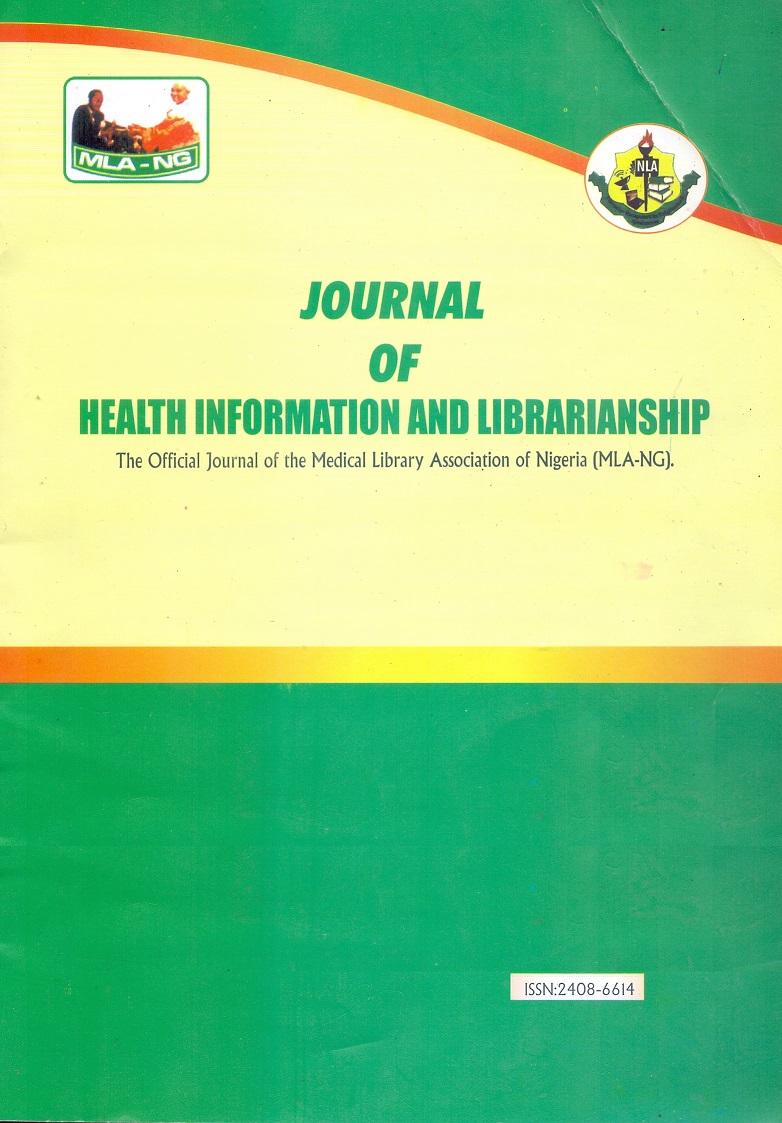Theory of Information Behaviour as a Theoretical Framework for Understanding Non-Compliance to Child Spacing Information: A Fresh Perspective for Designing Child Spacing Information Services and Communication Programs
Main Article Content
Abstract
Background: Non-compliance with child spacing is a major public health problem and a leading cause of maternal mortality. This study aimed to explore the socio-cultural reasons for non-compliance with child spacing information. Using Chatman’s (2000) theory of normative behaviour as a theoretical framework to guide the investigation.
Method: The study adopted an interpretative research paradigm and also a qualitative research method, guided data collection, data analysis, data interpretation, and discussion of findings. Twenty-five childbearing women were interviewed using a semi-structured interview. The study adopted an analytic inductive process to identify 235 narratives explaining socio-cultural reasons for non-compliance with child spacing information. The narratives are organised into 13 recurring topics and further collapsed into six emergent categories to explain the socio-cultural reasons for non-compliance with child spacing information.
Results: Findings indicated that availability of child spacing information, Beliefs, and practice related to child spacing information, spouse resistance to child spacing information, fear and misinformation relating to child spacing information, suspicion of Western people, distrust in mass media and health care providers are the major findings of this study.
Conclusion: Findings interpreted using Chatman’s (2000) theory of normative behaviour conclude that for there to be a sustained acceptance and use of child spacing methods, there is a critical need for child spacing information program, to design child spacing information services based on the social and cultural dynamics of the child-bearing women who are resistance to child spacing information and services. Future research areas for sustained acceptance of the child spacing information services are identified.
Downloads
Article Details

This work is licensed under a Creative Commons Attribution-NonCommercial 4.0 International License.
CC-BY-NC
How to Cite
References
Abubakar, A. (2015). The Need for a Budget Line Family Planning/Child Spacing in Kaduna State: Role of Commissioner for Local Government.
Agudelo, A. (2004) Effects of Birth Spacing on Maternal, Perinatal, Infant, and Child Health: A Systematic Review of causal Mechanisms. Study Fam Plann 2012, 43(2):93–114.
Ahmed, S., Li, Q., Liu, L., & Tsui, A. O. (2012). Maternal deaths averted by contraceptive use: analysis of 172 countries. The Lancet, 38 0,111-125. http://dx.doi.org/10.1016/S01406736(12)60478-4
Bawah, R. (2002) Attitude and Willingness of Men Towards the Use of Modern Family Planning Methods in Budondo Sub-County, Jinja, Uganda. 101 (6), 1089-1095
Burnett, G. (2009). Colliding norms, community, and the place of online information: The case of Archive.org. Library Trends, 57(4), 694-710.
Burnett, G., Jaeger, P. T., & Thompson, K.M. (2008). Normative behaviour and information the social aspects of information access. Libraryand Information Science Research, 30, 56-66. doi.org/10.1016/j.lisr.2007.07.003
Chatman, E. A. (2000). Framing social life in theory and research. The New Review of Information Behaviour and Research, 1, 3-17.
Davanzo, J. Abdurrazzaque, M. R. Hale, A. Ali, M. Mustafa, G. G. Kaniz. (2004). The effects of birth spacing on infant and child mortality, pregnancy outcomes, and maternal morbidity and mortality in matlab, Bangladesh. WR-198
Graneheim, L. and Lundman, G. (2004). Qualitative Analysis of Analysis. Applications of Social Research Methods to Questions (pp.308-319).
KSRHK (2014) Kaduna State Reproductive Health Statistic on Family Planning/Child Spacing Services Advocacy Kit Kaduna State.
Link, B. (2011) Perceptions of family planning among low-income men in Western Kenya. International nursing review. 56 (3), 340-345.
Mapembeni, K. (2007) Family Health in a Rural Appalachian Ohio County. [Meigs County]. Journal of Appalachian Studies, 2 (Fall): 299- 310.
Musa, I. (2013). Resistance to Polio Immunization Information in Kano, Nigeria, A Dissertation Presented to School of Library and Information Management, Emporia state university.
Musa, A. I. (2015). Polio immunization social norms in Kano state, Nigeria: Implications for designing polio immunization information and communication programs for routine immunization services. Global Health Communication, 1(1), 21–31. doi.org/10.1080/23762004.2016.1161419
NURHI (2015) Family Planning Social Mapping in Ibadan and Kaduna Nigeria, Report
NDHS. (2013) Birth Spacing Programmatic Review: An Assessment of Country-Level Programs, Communications and Training Materials. POPTECH Publication No.2003-154-024, 2004
Orji, M. (2006) Contraceptive Awareness Among Men in Bangladesh." J Fam Plann Report Health Care, 32 (2): 100-3.
Renne, E.P. (2006) Perceptions of population and development in Northern Nigeria, Studies in Family Planning 27(3):127-136. n.d. Changing assessments of abortion in a Northern Nigerian town. In: Abortion in a Changing World, A. Basu, ed. Oxford: Clarendon Press, forthcoming.
Robert, R. (2014) Rotary Project MG 53403A model to reduce maternal and fetal mortality and morbidity in 10 hospitals in Kano and Kaduna state, Nigeria.

